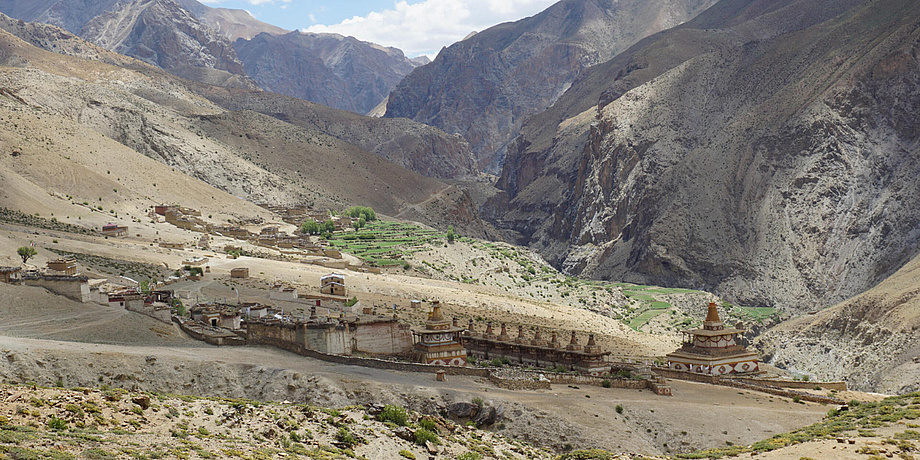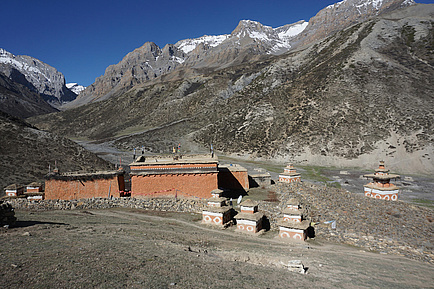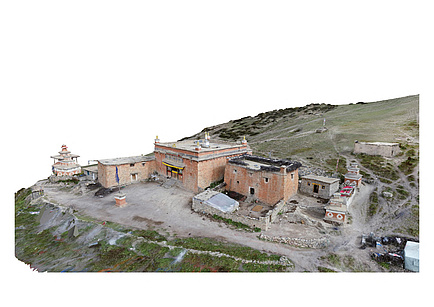In the high-altitude and extremely remote region of Dolpo in north-west Nepal, there are numerous Buddhist temples whose history dates back to the 11th century. The structures are threatened by earthquakes, landslides and planned infrastructure projects such as the Chinese Belt and Road Initiative. There is also a lack of financial resources for long-term maintenance. Researchers from the Institute of Architectural Theory, History of Art and Cultural Studies and the Institute of Engineering Geodesy and Measurement Systems at Graz University of Technology (TU Graz) want to prevent the loss of this cultural heritage, which has hardly been researched up to now. With the support of the Austrian Science Fund FWF, they have documented, analysed and measured buildings as part of several expeditions and preserved some of the temple complexes as 3D computer models – and could thus also have contributed to the preservation of the real buildings. The results have now been published in the journal “Heritage”.
Creating new knowledge
“Written and pictorial sources about the temples in Dolpo are rare, so the buildings themselves usually provide the most reliable information on their history. With our research, we wanted to create new knowledge about the sacred architecture of the region and categorise the existing buildings in their historical and art-historical context,” says Carmen Auer from the Institute of Architectural Theory, History of Art and Cultural Studies. Together with her team, she has been carrying out research on the regions of the western Himalayas since the early 2000s as part of various Austrian Science Fund projects and collaborations. “Our research results are publicly accessible to everyone. They also provide a basis for possible renovations of the temple complexes and raise awareness of the value of this cultural heritage in the region and beyond. This increased attention will hopefully also help to ensure that more funds are made available for the maintenance of the facilities.”
Adapted measurement methods
Due to the remoteness of Dolpo and the high deployment altitudes, intensive preparatory work on suitable surveying methods was necessary. The area is only accessible on foot and with pack animals, so the weight of the instruments had to be kept to a minimum. In addition, there is hardly any electricity or internet in the region, which is why the researchers had to resort to solar panels and batteries and adapt the software used so that it could function without contact to the manufacturer’s server.
Helmut Woschitz and Peter Bauer from the Institute of Engineering Geodesy and Measurement Systems used a 3D surveying technique involving a laser scanner, a surveying total station, a mini-drone and a DSLR camera. Fundamental investigations in the geodetic measurement laboratory at TU Graz contributed significantly to the further development of the instruments and measurement methods. The chosen equipment made it possible to record inscriptions, sculptures and wall and ceiling paintings in addition to the building fabric. Using the data obtained in this way, the research team created 3D models and 2D plans (site plans, floor plans, sections, views) that provide insights into the building structure, for example of the Nesar Temple: https://igms.3dworld.tugraz.at/HomepageBijer.html.
18 Buddhist sites documented so far
During four research visits between 2018 and 2023, the TU Graz research team included a total of 18 Buddhist sites in the documentation, of which 16 assemblies have already been surveyed and analysed. “They are part of a sacred landscape that has developed over centuries. The choice of location, the type of building and the orientation of the buildings are shaped by traditional narratives, geographical conditions and symbolic representations,” explains Carmen Auer. In order to understand these processes, an open dialogue with the local population, comprehensive documentation and interdisciplinary cooperation were necessary.
For the future there are plans to explore the northernmost region of Dolpo around Yangtze Monastery near the border with Tibet, where many buildings have not yet been documented.
Publication: Surveying a Sacred Landscape: First Steps to a Holistic Documentation of Buddhist Architecture in Dolpo
Author: Carmen Elisabeth Auer
In: Heritage 2025, 8(9)
DOI: https://doi.org/10.3390/heritage8090385
Website: https://archresearch.tugraz.at




